Posted: May 5th, 2009 | Author: Meng Xing | Filed under: waste industries | Tags: ecopolitics, urban development | No Comments »
Zehle (2008) indicated the notion of “network ecologies”. Urban development in many cities of the world will be influenced by local, national and regional politics and institutions. Local and national politics have played the most important role in current urban development. Industrialization which is rapidly developing in China results in a mass consumerism through material gain. Zehle (2008) mentions that the recycling yards around Beijing are sprawling. Urban development needs resources and produces wastes.
According to Conley (1997), Ecopolitics is a study of environmental awareness – or non-awareness. It means that we think about the conditions of life, space and the world in an ecological way. Verena Andermatt Conley gave strong ecological consciousness which can make long-range effects. Ecopolitics poses questions to technologies and concerns with the environment.
Neo-industrialization in the new economy is an integral approach to economy, ecology and space and bringing in new activities. Although Hong Kong, Shanghai, and Beijing are well developed, Petersen (2003) argues that in the global market, Chinese companies lack competition because of the limits of capital, advanced technology, developed markets, and name brand recognition. It is hard to for Chinese companies to reduce costs and increase profits. Many national companies will take a risk of going bankrupt. This will result in social problems such as: unemployment. Furthermore, during the urban development, rural labor will be eager to move to the urban areas. However, their working condition and life quality are not optimistic.
Zehle S (2008) ‘Network Ecologies: Documenting Depletion, Exhausting Exposure‘, Urban China 33: 30-31.
Petersen K (2003) China,Neoliberalism,and the WTO.Retrieved April 26, 2009 from http://dissidentvoice.org/Articles7/Petersen_China-WTO.htm
Conley VA (1997) Ecopolitics: the environment in poststructuralist thought, Routledge, London. Retrieved April 26, 2009 from ebrary database.
Posted: May 5th, 2009 | Author: Shui Jing | Filed under: creative industries, real-estate, theory | No Comments »
According to Van (2009), at present, the network cluster formed with accumulation regime. Additionally, creative cluster is the sub-cluster from industrial clusters.
There are some connections between urban development and competitive power ,when one company was classifying into creative industry spatial agglomeration.
Van mentioned, originally, in Berlin, some real estate of important creative cluster was organized by shareholder project format. Afterwards, from 2004 it’s transformed into ‘regional management’. In other words, the government intervenes in this area and begins to corporate with real estate developer.
In London, even the spatial clusters were sorted out ambiguously, the tendency of creative cluster is exist.
Van also uses Maskell(2001) notes to analyze cluster and development in creative industry from the three aspects.
First of all, some firms are willing to relocate or partly relocate into cluster for potential customers in such area. For example, the Magazine of Urban China relocated their Shanghai Branch office instead of moving in one of creative industry park in Yangpu District.
In addition, some dominant tendency also will lead some firms to think about what sector of creative industry they should get involved in. Give an example, In Ningbo, the project of Industrial Design and Creative Park will give lots of opportunity for design studios and advertising companies. Owing to this creative park already have some relationships with manufacturing companies in Ningbo. According to Hu (2009), on account of the small medium scale manufactures in Ningbo had developed very well. However, if they want achieve better performance; the reality is that their ability is limited for reason of lack of industrial design skill. Therefore, in such situation, design studios in the Industrial Design and Creative Park will definitely have closed relationship with these enterprises. In other words, small medium scale manufactures could benefit from design and their products appearance will be showed in such creative park. In the end, products will get great demand. On the other hand, design studio also could through these designs to demonstrate their strength and gain money.
Finally, the phenomenon of new firms as the spin-offs in cluster becomes more and more common in daily life. Because of technical shift and commercialization, such companies are the good places for staff to expand their imagines and creativity. Do those company forms appear in Ningbo? Next step, I want to interview some persons and figure it out.
One of blueprint of Ningbo Industrial Design and Creative Park

Van Heur, Bas (forthcoming 2009) ‘The Clustering of Creative Networks: Between Myth and Reality’, Urban Studies 46.9.
Hu, Haizhong & Xiao Yingzhe 2009, ‘On interactive relationship between Ningbo constructing industrial park and developing small-medium scale manufactures’, Journal of Zhejiang Wanli University,vol.22,no.1,pp.83-86.
Posted: May 5th, 2009 | Author: Fu Hanqing | Filed under: creative industries | Tags: Ningbo museum | 1 Comment »
Ningbo museum is located in the south east district of Ningbo city, with an area of about 4 hectares, a floor area of about 30000 square meters and 16,000 collections. It is one of the eight cultural projects which Ningbo government majorly constructed. Drawing upon its two major advantages, creative architecture and creative exhibitions, Ningbo museum came to the fore in China which has all kinds of museums.
Ningbo Museum, 1000 Shounan Road (M), Yinzhou, Ningbo, China

Creative Architecture
The style of architecture of Ningbo Museum is called ‘new interpretative attitude’. The idea of this style do not venerate the unchanging design patterns but stress to use local materials and methods in design. Ningbo museum is laden with a lot of cultural information of Ningbo. First of all, Ningbo museum is architecture of ‘half mountains and half houses’. The building has a list to the south which symbolized the local landform of mountain. An expanse of water traverses the major entrance, rounding the whole building. It indicates the development of Ningbo from ferry to estuary and thence to port.
Expanse of Water & ‘half mountains and half houses’
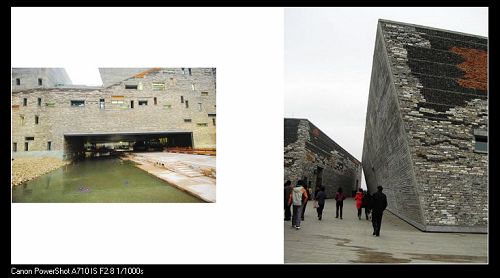
Secondly, the main attraction of this museum is the ‘tile wall’ and special concrete wall. Millions of old tiles, involving blue bricks, keel bricks and tiles, since Ming and Qing dynasties were used to build up this museum. The meaning of this tile wall is equal to the idea of ‘collecting history’. Besides, the special concrete wall is made up by displaying the grain of bamboo on the wall. Bamboo can show the typical characters of the culture of south Yangzi River and impose the historical information. With this style of architecture, Ningbo museum itself becomes an exhibit.
Titles Wall & Bamboo Concrete Wall
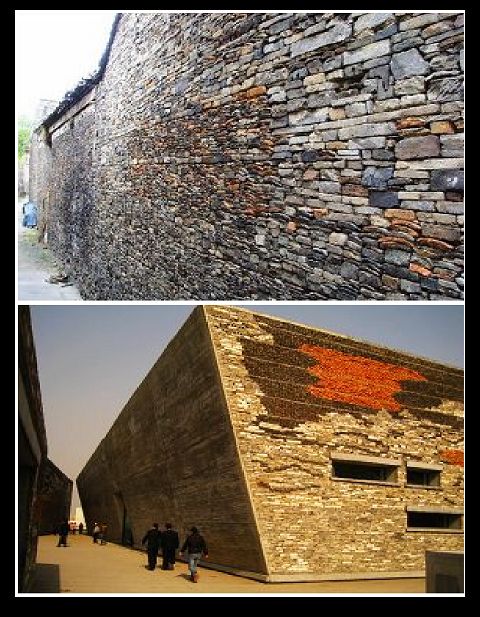
Creative Exhibitions
There five major exhibition halls to fully display the history and culture of Ningbo. The first one is the display of Ningbo history. Four specialties should be pointed out. Firstly, the structure of showing the history bases on the ecological construction which considered the historical development as the Y-axis and the turning points as the X-axis. Secondly, Ningbo museum uses the historical materials to support the display and cultural relics to provide the display. Thirdly, new technologies are used in exhibitions to deepen the understanding and feeling of visitors. Last, the geographic features of Ningbo gave prominence to the theme of ‘water’.
Ecological Construction & Historical Materials
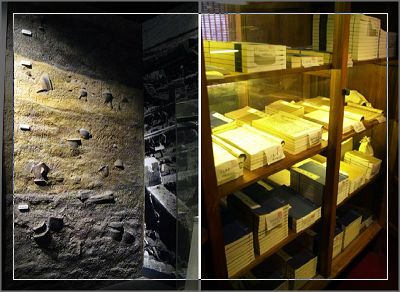
Multimedia & the Theme of Water
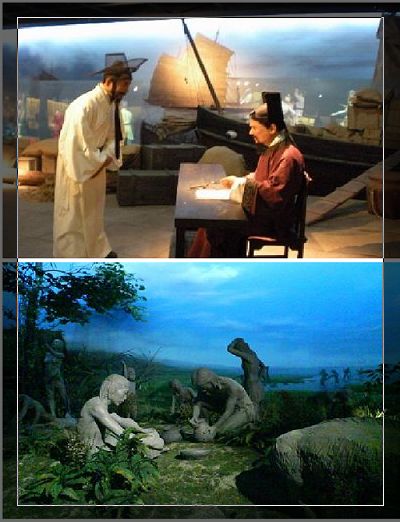
The second exhibition hall is bamboo carvings. This exhibition hall displays traditional culture from both form and content. From the perspective of form, the Chinese traditional method of ‘borrow scenery’ and traditional exhibition shelves is applied in display to heighten visual effects. From the perspective of content, these collections are ‘the most important bamboo carving collection extant in China and is definitely ranked the top level of its kind whether judged by quality and quantity’ ( Shixiang & Jiajin n.d.)
‘Borrow Scenery’ and Traditional Exhibition Shelve
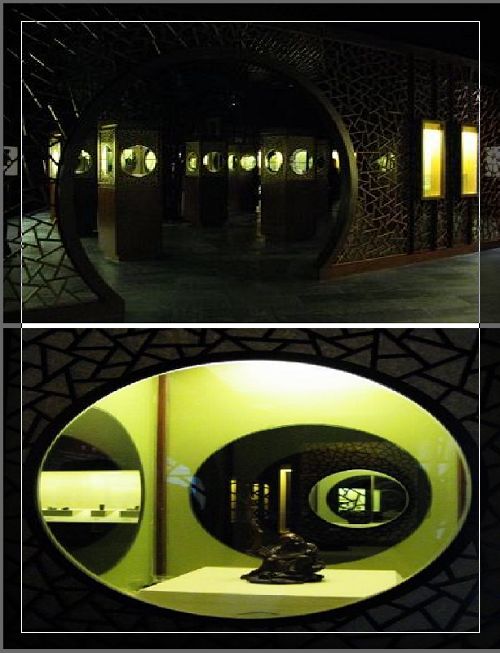
The third exhibition hall is the display of Ningbo customs consisted of Ningbo old-established brands, Ningbo wedding customs, Ningbo houses, Ningbo calendar, Ningbo craftsmanship and Ningbo opera and dialect. All these customs were the hallmark in Ningbo history and culture.
Ningbo Customs.
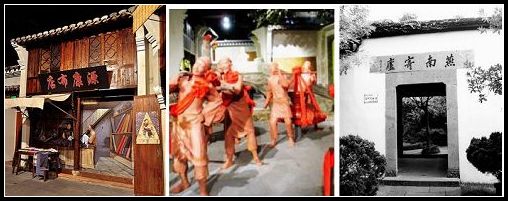

The remaining two exhibition halls are respectively special exhibition of royal jewel and art works donated by Shao keeping. Special exhibitions always changed with the plans of display.
Princes Gold & Silver Works
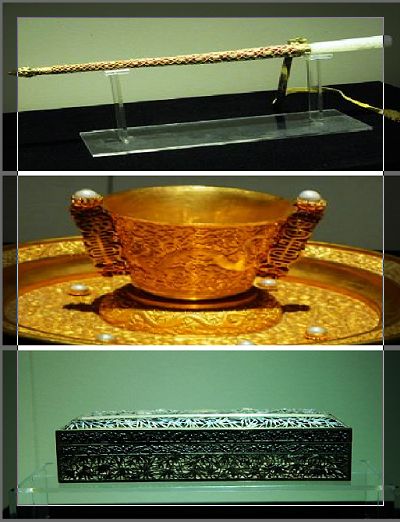
With these creative elements, Ningbo museum has become a particular cultural palace where people understand history and learn more about the world.











Recent Comments